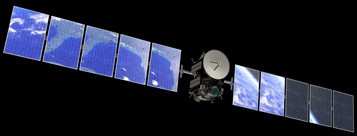Sun, Nov 23, 2008
Probe Powers Down Its Ion Drive As Scheduled
NASA's Dawn spacecraft shut down its ion propulsion system
Thursday as scheduled. The spacecraft is now gliding toward a Mars
flyby in February of next year.

"Dawn has completed the thrusting it needs to use Mars for a
gravity assist to help get us to Vesta," said Marc Rayman, Dawn's
chief engineer, of NASA's Jet Propulsion Laboratory, Pasadena, CA.
"Dawn will now coast in its orbit around the sun for the next half
a year before we again fire up the ion propulsion system to
continue our journey to the asteroid belt."
Dawn's ion engines may get a short workout next January to
provide any final orbital adjustments prior to its encounter with
the Red Planet. Ions are also scheduled to fly out of the
propulsion system during some systems testing in spring. But
mostly, Dawn's three ion engines will remain silent until June,
when they will again speed Dawn toward its first appointment, with
asteroid Vesta.
Dawn's ion engines are vital to the success of the misson's
8-year, 3-billion-mile journey to asteroid Vesta and dwarf planet
Ceres. One of these extremely frugal powerhouses can generate more
than 24 hours of thrusting while consuming about 9 ounces of the
spacecraft's xenon fuel supply -- less than the contents of a can
of soda. Over their lifetime, Dawn's three ion propulsion engines
will fire cumulatively for about 50,000 hours (over five years) --
a record for spacecraft.
Dawn will begin its exploration of asteroid Vesta in 2011 and
the dwarf planet Ceres in 2015. These two icons of the asteroid
belt have been witness to so much of our solar system's history. By
utilizing the same set of instruments at two separate destinations,
scientists can more accurately formulate comparisons and contrasts.
Dawn's science instrument suite will measure shape, surface
topography, tectonic history, elemental and mineral composition,
and will seek out water-bearing minerals. In addition, the Dawn
spacecraft itself and how it orbits both Vesta and Ceres will be
used to measure the celestial bodies' masses and gravity
fields.
The Dawn mission to asteroid Vesta and dwarf planet Ceres is
managed and operated by JPL for NASA's Science Mission Directorate,
Washington, DC.
More News
Also: B-29 Superfortress Reunion, FAA Wants Controllers, Spirit Airlines Pulls Back, Gogo Galileo Van's Aircraft posted a short video recapping the goings-on around their reorganiz>[...]
Light Gun A handheld directional light signaling device which emits a brilliant narrow beam of white, green, or red light as selected by the tower controller. The color and type of>[...]
"The journey to this achievement started nearly a decade ago when a freshly commissioned Gentry, driven by a fascination with new technologies and a desire to contribute significan>[...]
"Our driven and innovative team of military and civilian Airmen delivers combat power daily, ensuring our nation is ready today and tomorrow." Source: General Duke Richardson, AFMC>[...]
Aircraft Conflict Predicted conflict, within EDST of two aircraft, or between aircraft and airspace. A Red alert is used for conflicts when the predicted minimum separation is 5 na>[...]
 Airborne 04.16.24: RV Update, Affordable Flying Expo, Diamond Lil
Airborne 04.16.24: RV Update, Affordable Flying Expo, Diamond Lil ANN's Daily Aero-Term (04.20.24): Light Gun
ANN's Daily Aero-Term (04.20.24): Light Gun Aero-News: Quote of the Day (04.20.24)
Aero-News: Quote of the Day (04.20.24) Aero-News: Quote of the Day (04.21.24)
Aero-News: Quote of the Day (04.21.24) ANN's Daily Aero-Term (04.21.24): Aircraft Conflict
ANN's Daily Aero-Term (04.21.24): Aircraft Conflict



